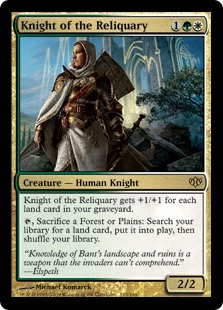Introduction
Top 3 things I did not think would happen last week-end:
# Me following a Grand Prix I did not know was going to happen the day before
# Skred Red winning a game of Magic, or in that instance this entire Grand Prix
# Me wanting to brew in Modern
Yet, all three of those things did happen. See, I consider Modern to be an interesting case of a diverse, and yet stable format. In standard, you usually see plenty of decks at first, and then stabilize around three to five playable decks where everything thing else is either a stroke of genius (1% of the time) or a strictly inferior, yet cooler, option (all the rest). In Modern, you always have around 20 legitimate decks doing the metagame dance, but I was quite convinced that those 20 decks were clearly better than everything else and that we would not see anything new pop up.
Conclusion? I was wrong. Skred Red, a deck that I admit not giving any credit to, won the whole thing. Not only that, but it did so by breaking one of the fundamental rules of Modern which is (or was?) “do not play four-mana spells that do not either win the game like 《Scapeshift》 or that is called 《Cryptic Command》”.
The whole thing made we want to try and play with some brews. I mean, I always knew that Modern was still full of unexploited archetypes and synergies, but I needed someone to prove there was still room for those to compete with tier 1 strategies. That GP that I did not even attend lit a fire under my ass, and I started looking for the most random brew I could try and tune.
Nayashift|
1 《Forest》 1 《Mountain》 4 《Sacred Foundry》 4 《Stomping Ground》 1 《Temple Garden》 4 《Windswept Heath》 4 《Wooded Foothills》 4 《Flagstones of Trokair》 4 《Valakut, the Molten Pinnacle》 1 《Sejiri Steppe》 -Lands (28)- 4 《Steppe Lynx》 4 《Plated Geopede》 4 《Knight of the Reliquary》 -Creatures (12)- |
4 《Explore》 4 《Manamorphose》 4 《Boom // Bust》 4 《Scapeshift》 4 《Prismatic Omen》 -Spells (20)- |
4 《Path to Exile》 4 《Pyroclasm》 4 《Stony Silence》 1 《Rest in Peace》 1 《Bojuka Bog》 1 《Soaring Seacliff》 -Sideboards (15)- |

This is a deck that someone went deep with at Grand Prix Lille 2016, finishing 49th in a very large Grand Prix where I have no doubt no one else was playing the same archetype. It is awkward, it is brutal, and it is not something I would have built myself.
 | 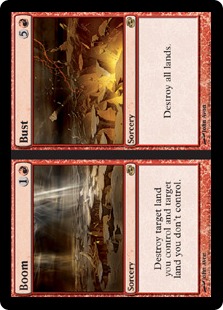 |  |
Let me start with the obvious weaknesses that make this deck a typical brew, and a pretty savage one. What struck me first upon looking at the deck is how loose it seems: there is no clear plan, or, more precisely, there are a few too many plans. You basically try to kill them through massive swings with 《Plated Geopede》 and 《Knight of the Reliquary》, try to get them stuck on lands via 《Boom // Bust》 (mostly the Boom part, I’d say), but also prepare to one-shot them with the 《Scapeshift》 + 《Prismatic Omen》 combo. Yes, that is just one deck. This approach has a bunch of obvious issues, where cards would not synergize too well with each other: 《Prismatic Omen》 does not sound too exciting as a follow-up to 《Steppe Lynx》, and opening a hand with 《Boom // Bust》 and 《Scapeshift》 is not a pleasant proposition.
But this is very much of a half-empty half-full dilemma. So, let me give you the more optimistic approach: this deck contains two very powerful combos, the one with 《Scapeshift》 and the 《Boom // Bust》 + 《Knight of the Reliquary》 interaction. Sometimes you draw them right, sometimes not. But the rest of the deck does a very neat job of making it come together most of the time: since both of your combos are reliant on you putting lands into play (either to cast 《Scapeshift》 or Bust), the 8 landfall beaters just happen to work with literally every enabler in your deck (ok, except for 《Prismatic Omen》 that does not do much outside of making 《Scapeshift》 lethal). So, instead of looking at this as a “double combo with random aggressive beaters”, you can think of it as a synergistic aggro deck that can also build up towards a combo kill after you stabilize.
None of the plans are so by themselves great: the aggressive plan is not quite as resilient as Burn (they just need to kill one or two landfall creatures), and the combo part requires you to draw it naturally while not having too many ways to protect it from discard or counterspell. But that also means they are so much harder to attack: you want to draw removals against plan A, discard and countermagic against plan B, while applying some pressure because they can still just kill you with 《Prismatic Omen》 + lands given enough time. Not all the decks pack such diverse answers, and even when they do, they would need to draw them in the exact right order (《Remand》 is not a very good card when faced with a turn 1 《Steppe Lynx》, that should easily to more than 4 damage per turn is this shell). For this reason, I can understand that this deck should be a very problematic match-up for someone trying to control it, say Jund or Grixis control, and that means there are some metagames where it could be an exciting option if you want to play unfair while dodging the regular hate.
Playing against a faster proactive deck would be a different story, though: you still have a fighting chance with your aggressive plan, because a turn 1 《Steppe Lynx》, turn 2 《Plated Geopede》 is an extremely fast clock when left unchecked, but you can already forget about your own combos: they will just be way too slow, and you have no way of buying time main deck. Burn, for example, look hopeless for you.
This all means that this deck has a very well-defined place in the metagame, even though it is completely under the radar: it is a deck that is here to pray of reactive decks, especially the ones that try to play fair. It might actually be a decent place to be, since Jund and Junk are two really powerful decks right now that you will beat most of the time.
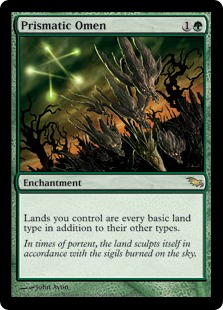 | 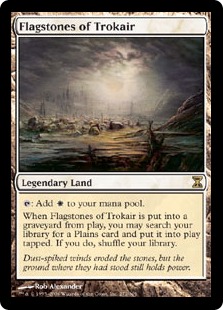 | 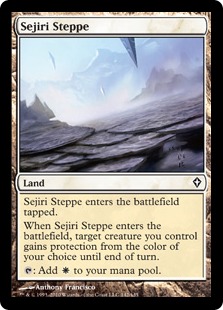 |
Going forwards, I think some improvements can be made; namely, it looks like 《Prismatic Omen》 is there almost only to let you kill with 《Scapeshift》 AND play a super greedy manabase with 《Flagstones of Trokair》 instead of fetchlands and 《Sejiri Steppe》. So, greedy, in fact, that you end up running Manamorphose simply to hit your colour requirement. Thing is, you “only” play three colours and you want fetchlands anyway, so you could just not run the Omen and still get to kill with 《Scapeshift》. Perhaps more importantly, the main issue with playing 《Scapeshift》 without Omen is that your 《Scapeshift》 will usually deal 18 instead of 84. I admit that it not quite as cool, but if you are going to be running 《Steppe Lynx》, I am hoping that your opponent will not be over 18 life by turn 6-7, so the result will be the same.
What I have in mind is something like this:
|
4 《Mountain》 1 《Forest》 1 《Plains》 4 《Sacred Foundry》 4 《Stomping Ground》 1 《Temple Garden》 4 《Arid Mesa》 4 《Wooded Foothills》 3 《Windswept Heath》 2 《Valakut, the Molten Pinnacle》 -Lands (28)- 4 《Steppe Lynx》 4 《Plated Geopede》 4 《Knight of the Reliquary》 2 《Oracle of Mul Daya》 2 《Primeval Titan》 -Creatures (16)- |
4 《Lightning Bolt》 4 《Explore》 4 《Boom // Bust》 4 《Scapeshift》 -Spells (16)- |
4 《Path to Exile》 3 《Courser of Kruphix》 3 《Stony Silence》 3 《Rest in Peace》 1 《Shatterstorm》 1 《Bojuka Bog》 -Sideboards (15)- |

So, what I did is change the manabase: we went from 9 to 12 mountains, which should be enough to let us find 6 mountains+1 valakut when we cast 《Scapeshift》 with only 7 lands into play. Since I also removed the 《Flagstones of Trokair》 and the lone 《Sejiri Steppe》, the mana remains very decent.
Now that we do not have to play neither 《Prismatic Omen》 nor 《Manamorphose》, I decided to streamline my deck a little bit with 4 Lightning Bolt; I like how it supports every aspect of you plans, giving your aggressive draws a bit of reach, letting you interact when you are on the slower side, and possibly getting your opponent at 17 before a lethal 《Scapeshift》 if that is ever necessary. A lone bolt might sound like too little of an interaction against something like infect, and it probably is, but keep in mind that you apply so much pressure that your opponent should not be able to play around it as well as against more controlish decks.
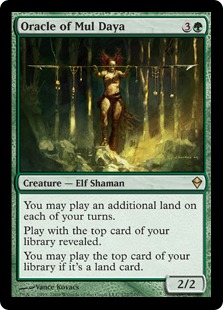 | 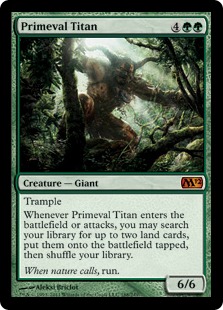 |
The second idea was to run 2 《Oracle of Mul Daya》 and 2 《Primeval Titan》. Both cards essentially tie your deck together so well that you should win almost anytime you untap with them. The Oracle has been especially impressive, giving your early creatures a welcome punch while ramping into your combos AND helping you filter your draws with fetchlands to draw those combos, which is something the original version of the deck desperately needed. It remains very fragile, but my hope is that my opponent will need to spend his removals on my first beaters anyway. 《Primeval Titan》 is more straightforward, and is simply very powerful and very synergistic at the same time. I like having a card that packs such a punch to make sure that I have something to do with all my lands even when I am not comboing off.
The result is a deck that is a little more focused and down-to-earth; it is still capable of very impressive draws and attacks from a lot of angles without being subject to the miserable, paranoid hands the previous version had. The match-ups are still the same overall, but you increase your win percentage in good match-ups by a lot simply because you do not just lose to yourself as often.
As for the sideboard, I agree with the first list that you need to run some very powerful and targeted sideboard cards: I simply changed the mix a little, mostly because I would be primarily concerned with Dredge, Burn and Affinity. Those three decks are very proactive, but with a much lower fail rate that combo decks. Hence, if you let the match-up be bad, they will just beat you all the time: which is why you cannot allow it to be that bad post side. I have been happy with 《Courser of Kruphix》 in the sideboard, since it gains you at least as much like as a 《Kitchen Finks》 would while drawing you a lot of extra cards and not dying to the burn spells if you play around them.
So, should this be a tier1 deck? Not at all, nor did I ever thought it would. But I do think it is a fringe deck which power level is high enough that I could take to a GP and do well, given that I face the right metagame. It is both powerful, and very hard to stop, which is usually a very strong mix for a deck. The obvious weakness is the lack of counterplay when you face a deck that is faster and has absolutely no interest in stopping you, which is exactly why it can never be a go-to deck, but it will remain in my arsenal for the months to come, and I suggest you learn it too.
Until next time,
Pierre Dagen
Cards found in the Article
Share in Twitter
Share in Facebook
 Pierre Dagen
Pierre Dagen
One of Europe’s most well-recognized players, whom at Pro Tour: Theros squared off against his “Les Bleus” teammate Jeremy Dezani in a Mono-Blue Devotion mirror match in the finals, a game to go down in magic history. Other notable achievements include a second PT top8 in Honolulu 2016, 3 GP Top 8’s, and 3rd place at the World Magic Cup 2015 as captain of the French team.

Related Articles
- 2016/09/16
- Metagaming Modern With Martin Muller
- Martin Muller


